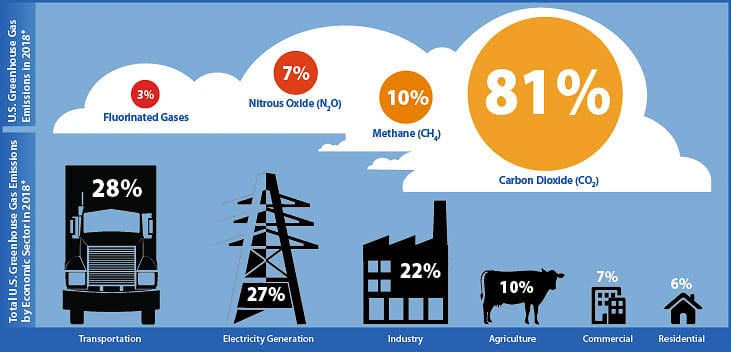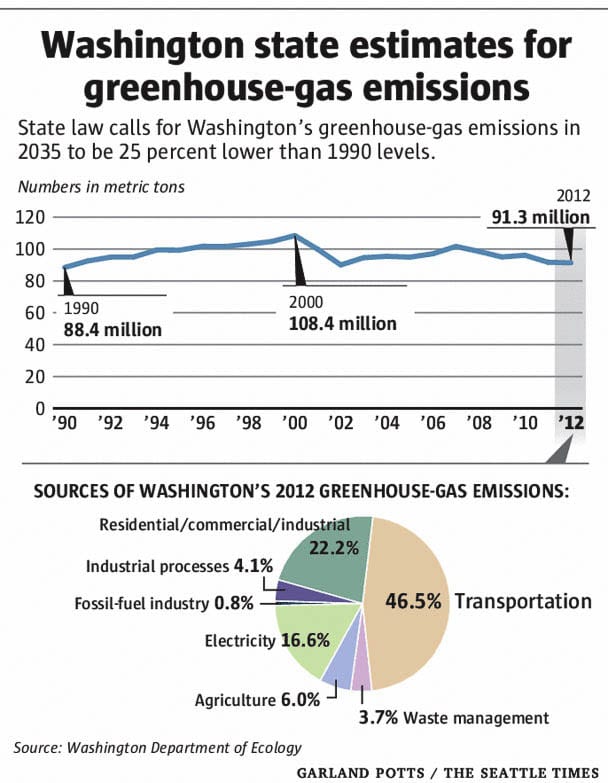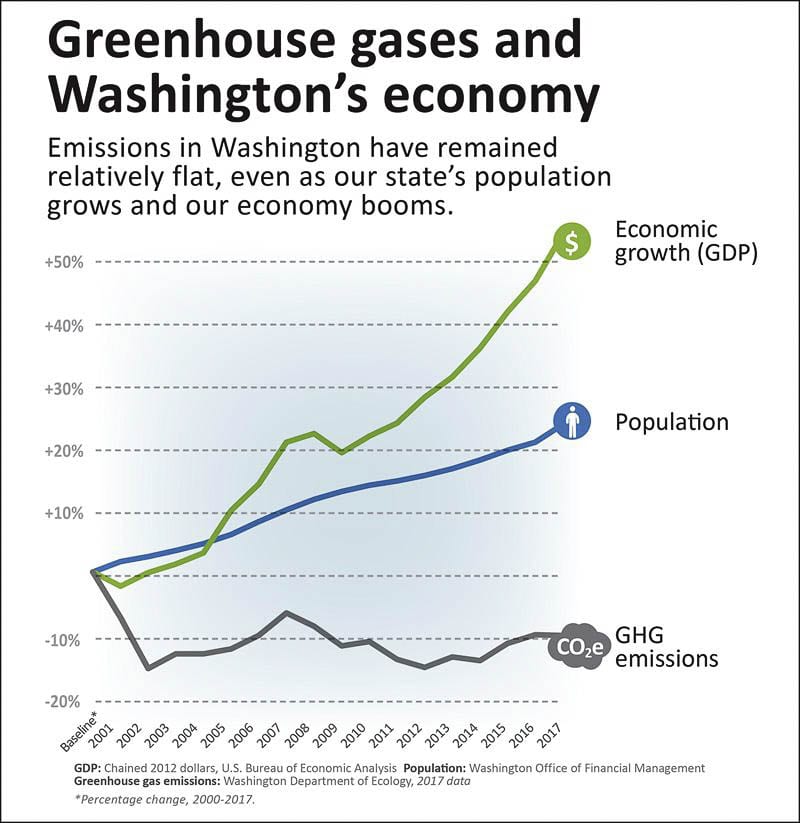Residential GHG emissions are among the smallest sector of the economy according to the EPA
Legislation developed by Washington Gov. Jay Inslee’s office could substantially reduce — and potentially eliminate — natural gas utilities’ ability to deliver energy to homes and businesses over the next 30 years. It would require homeowners to modify existing homes to electric heat and electric hot water by 2050.
Washington House Bill 1084, the Healthy Homes and Clean Buildings Act, would require all new construction in Washington to be zero-carbon by 2030. It would further seek to eliminate fossil fuel consumption in existing buildings by 2050, according to a Dec. 15, 2020 policy brief from Inslee’s office. The legislative text would provide a roadmap to phasing out gas utility service in Washington through changes to state code, regulatory mechanisms and incentives.
According to the Environmental Protection Agency, residential greenhouse gas (GHG) emissions at 6 percent are among the smallest sectors of the economy for emissions. Transportation accounts for 28 percent, four and a half times the GHG of residential emissions. Electricity generation accounts for 27 percent of GHG.

HB 1084 has 26 sponsors, including Rep. Monica Stonier (Democrat, 49th District). The companion bill is SB 5093, which has 11 sponsors, including Sen. Annette Cleveland (Democrat, 49th District). Neither responded to a request for comment.
The legislation would make Washington the first U.S. state to implement statewide restrictions on natural gas infrastructure in new construction, while simultaneously tackling retrofits in existing buildings, according to one report.
Rep. Paul Harris (Republican, 17th District) said via email “As written today I would absolutely oppose HB 1084.”
The bill had its first public hearing in the House Committee on Environment and Energy on Friday (Jan. 22). A bill analysis highlighted the following.
- Requires residential and nonresidential construction permitted under the 2027 State Energy Code to achieve at least a 70 percent reduction in annual net energy consumption and eliminate on-site fossil fuel combustion for space heating and water heating.
- Prohibits a natural gas utility from offering new service to any customer located outside of the area authorized in its approved certificate of public convenience and necessity as of July 1, 2021.
- Establishes a Statewide Clean Heat Standard for the purpose of limiting the expansion of the natural gas system for residential and commercial space and water heating, and advancing the use of high-efficiency electric equipment, the production and distribution of clean fuels, and the safe and equitable transition of the natural gas system.
- Requires the Utilities and Transportation Commission (UTC) to establish a uniform climate protection surcharge for natural gas utilities by January 1, 2023.
- Requires the Department of Commerce to adopt a state energy management and benchmarking requirement for tier 2 and tier 3 covered commercial buildings by November 1, 2021.
It mentions that builders “must construct increasingly energy efficient homes and buildings that help achieve the broader goal of building zero fossil-fuel greenhouse gas (GHG) emission homes and buildings by the year 2031.” Furthermore, the State Building Code Council must “adopt state energy codes that require buildings constructed from 2013 through 2031 to move incrementally toward a 70 percent reduction in energy use by 2031.”

Sen. Annette Cleveland, D-49 
Rep. Monica Stonier, D-49
Nowhere in the legislation is the cost of achieving these requirements mentioned. How much would it cost the average homeowner to retrofit their home, removing gas or oil furnaces and appliances, and installing electric appliances? There is no mention of how much these requirements will add to the price of a new home or apartment house.
John Fazzolari, of Fazzolari Construction, said it could run as high as $20,000 to retrofit an existing house with an electric furnace and hot water heater.
“If you’re switching from gas to electric, you’ll have to upgrade your power,” he said. “There will be new circuits that need to be run. And if you don’t have enough power, you’ll need to upgrade your service to your home.” That could involve new wiring and/or new circuit breakers. A worse case scenario would be if you have to upgrade your electric service, “the new building code requires new panels that include shut offs that could cost you thousands more,” Fazzolari said.
He also mentioned that there are high efficiency tankless gas water heaters currently available. “They don’t exist in electric systems.”
Consumer Reports backs up Fazzolari’s claims. “Tankless models are best for homes that use natural gas to heat the water; electric models might require an expensive upgrade of the home’s electrical capacity.” They additionally report “natural-gas water heaters typically use less energy and cost less to run (by about half) than electric water heaters, although you should note that gas models cost more at the time of purchase.”
Furthermore, there is no discussion on how electric utilities will generate enough electricity (without burning fossil fuels) to meet the increased demand for electricity.
Presently, Clark Public Utilities (CPU) serves over 211,000 electric customers in Clark County. They indicate 46 percent is hydropower purchased from the Bonneville Power Administration; 32 percent is produced at CPU’s River Road natural gas-fired generating plant; 6 percent is nuclear electricity; 4 percent is wind power generated; and 12 percent is market purchased power from non-specified sources.
Where will CPU get one third of its electricity for Clark County residents if they shut down their River Road power plant?
The utility responded to several questions submitted via email. They don’t see any current legislation that would require them to shut down the River Road power plant.
According to Dameon Pesanti of CPU, their Integrated Resource Plan includes the purchase of hydropower from the Bonneville Power Administration (BPA) for every megawatt they cannot generate at River Road due to new state laws limiting its output.
“We fully intend to comply with the provisions of the Clean Energy Transformation Act (CETA) by 2045 and we’re actively working to meet all requirements,” he said. “This timeframe was developed by the legislature to provide for resource adequacy in the region. We’re investigating many power supply options to meet this requirement. It is important to remember that many factors and technologies can change between now and then.”
Statewide, hydroelectric power typically accounts for more than two-thirds of Washington’s electricity generation. But a drought in 2019, caused hydropower production to drop to 62 percent of the state’s net generation, the smallest share of state generation in at least 30 years.

Natural gas is the second-largest source of in-state electricity generation. In 2019, it fueled about 15 percent of state generation, an increase from 9 percent the previous year. This highlighted the ability of natural gas to increase electricity production to meet demand, when hydroelectric power isn’t available. Nuclear power supplied about 8 percent of the state’s net generation in 2019. The Columbia nuclear plant is the state’s third-largest provider of power, after hydroelectricity and natural gas.
Citizens might wonder where there are presently homes available with “zero greenhouse gas emissions,” since the code states “building zero fossil-fuel GHG emission homes and buildings by the year 2031.” What is the cost of a “zero fossil-fuel GHG emission home?”
Tracy Doriot, owner of Doriot Construction, is a Clark County builder. “The entire energy code mandate has had a less than stellar rollout,” he said. “This is actually the 2018 update that has been put off numerous times. The builders, manufacturers as well as the building departments have no clue how to implement these changes. At this writing we do not even have updated energy calc sheets from WSU. They are the lead resource for streamlined compliance. Considering our moderate climate, most of this is unwarranted.“
Gov. Inslee announced this as part of his legislative priorities on Dec. 15. “Climate change is a health issue, an economic issue and an equity issue. We must address these very real threats to our state, and we cannot wait,” Inslee said.
“The time to act is now,” he said. “These proposals would reduce nearly 30 million metric tons of emissions by 2030 — a 35 percent reduction from current projections. And these standards and investments — with justice at their core — will grow clean energy jobs in Washington.”
In the legislation they create a new tax for natural gas utilities. By January 1, 2023, “the UTC must establish a ‘uniform climate protection surcharge’ at an amount not to exceed the social cost of GHG emissions established for the purposes of implementing the Natural Gas Conservation Standard.” There is also mention of a natural gas utility tariff beginning July 2021.
In 2018, Washington state voters rejected Initiative 1631, a proposed carbon fee on fossil-fuel emissions that spurred the biggest ballot-measure spending spree in state history. It was rejected in all but two counties.

The state’s largest emitter of carbon power generation was the TransAlta coal power plant near Centralia. In 2017 it was listed as emitting 6 million tons of CO2. In December, they shut down one of their two generators, presumably reducing their emissions by 3 million tons. The power plant will close by 2025.
Todd Myers of the Washington Policy Center shared the following last fall. “Since 2012, Washington’s CO2 emissions have increased nearly 8 percent. The state’s per-capita emissions fell only one percent between 2012 and 2018. By way of contrast, energy-related per capita CO2 emissions for the entire United States fell 5 percent between 2012 and 2017 (the most recent year available).”
The state’s carbon emissions peaked in 2000 at 108 million metric tons according to one report. The state’s population has grown from 5.9 million people in 2000 to 7.7 million in 2020, a 30 percent increase; yet carbon emissions were estimated to be below 100 million metric tons last year.
America’s greenhouse gas emissions from energy and industry plummeted more than 10 percent in 2020, reaching their lowest levels in at least three decades as the coronavirus pandemic slammed the brakes on the nation’s economy, according to an estimate published recently by the Rhodium Group.
America’s emissions had been steadily declining since 2005, in large part because utilities that generate electricity have been shifting away from coal, the dirtiest fossil fuel, in favor of cheaper and cleaner natural gas, wind and solar power. Over the past decade, utilities have retired hundreds of coal-burning power plants.






